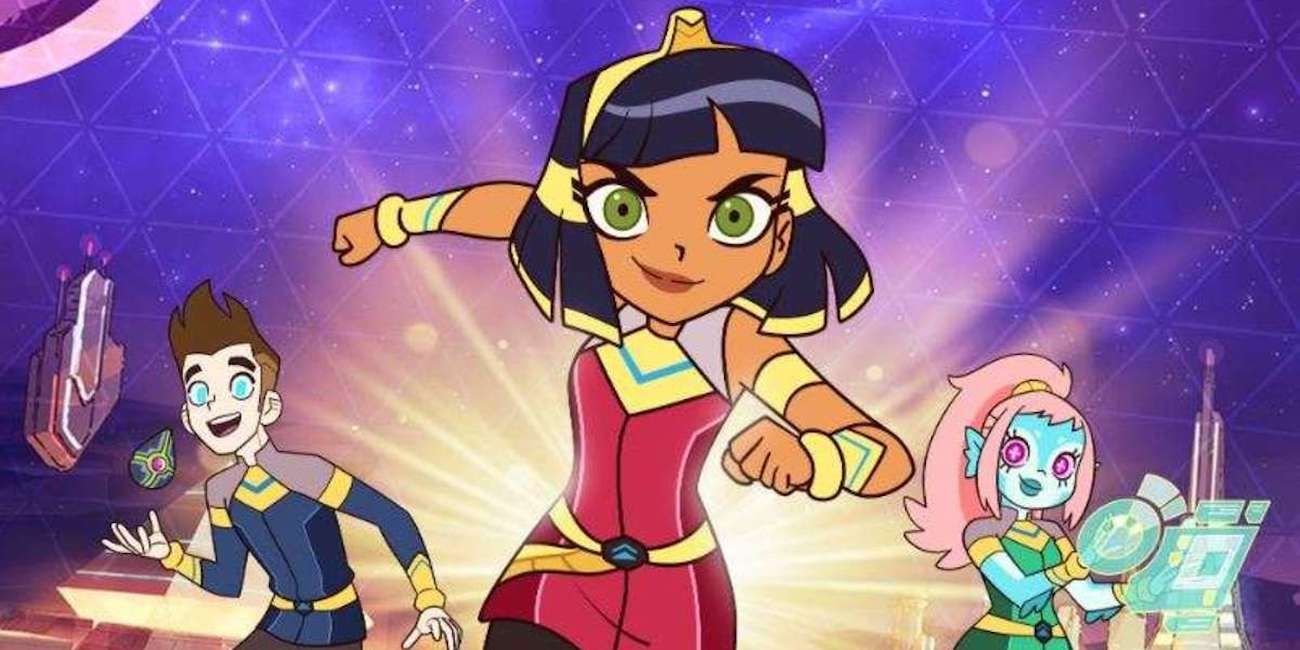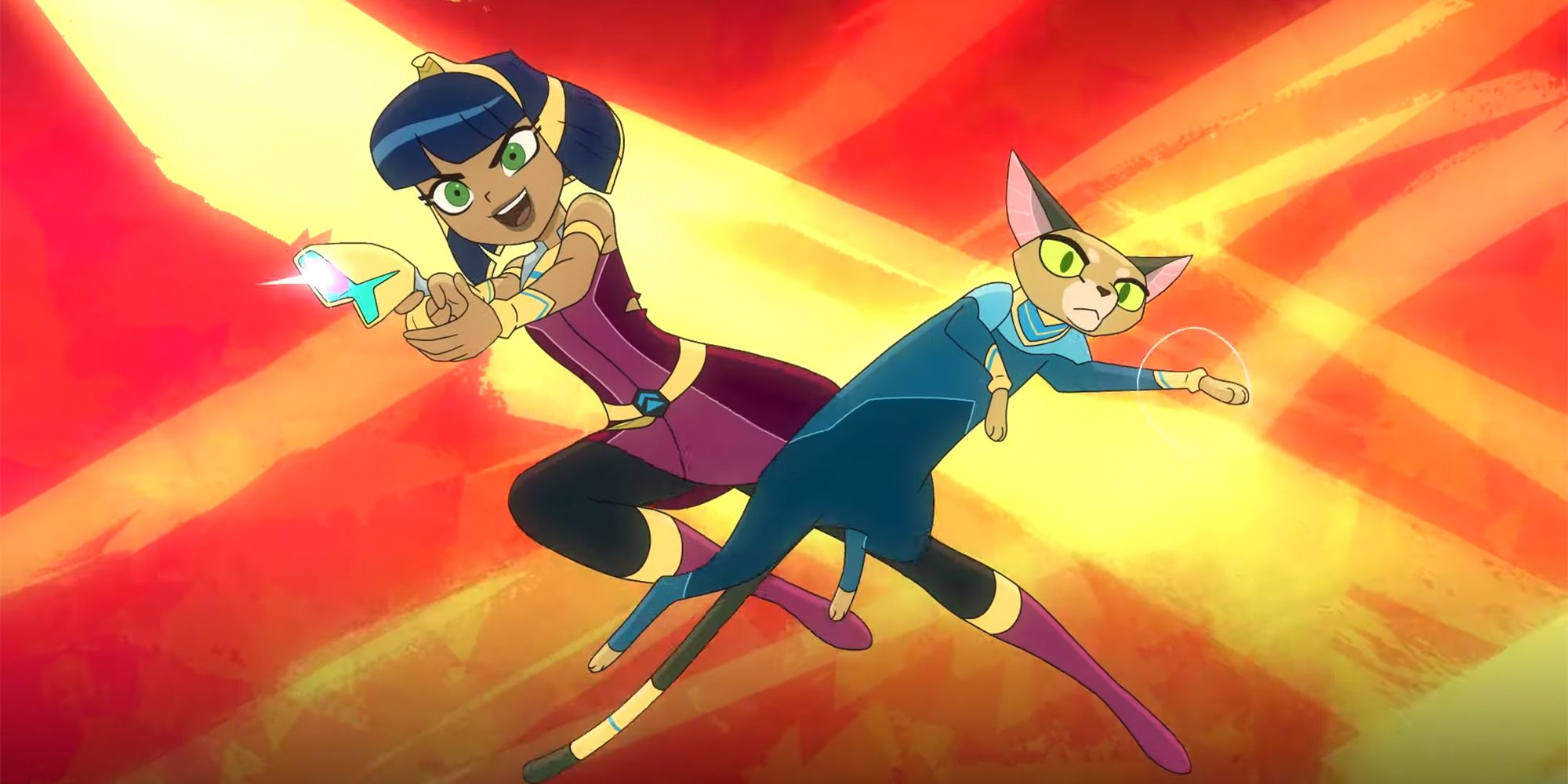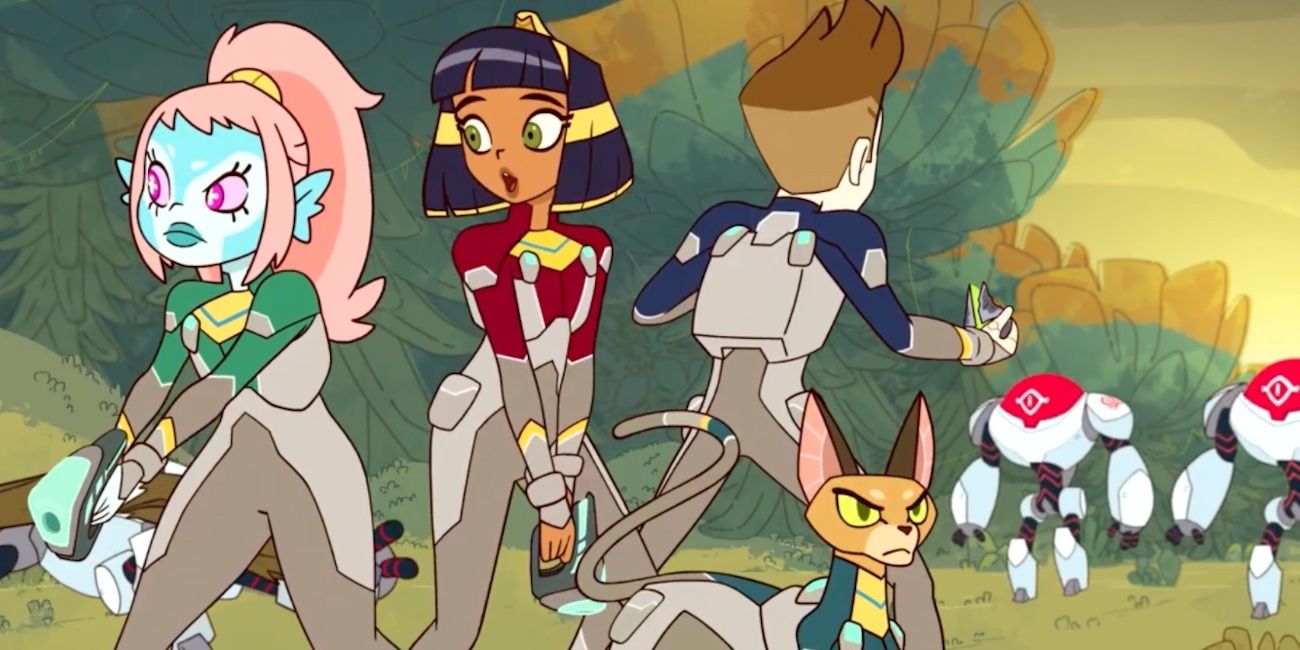The new animated series Cleopatra in Space is one of the flagship shows of the newly launched streaming service, Peacock. The show, which is adapted from Mike Maihack's graphic novels, centers on a confident, resourceful teenage Cleopatra (Lilimar Hernandez) who is transported through a magic portal from her home in ancient Egypt 2,000 years in the past to a planet ruled by talking cats 30,000 years in the future. There she learns she's prophesied to be the savior of the world, but since she has no combat skills, she's sent to PYRAMID Academy where she bonds with new besties, an alien who evolved from fish named Akila (Katie Crown) and a cyborg named Brian (Jorge Diaz), and encounters the typical high school mean girls. Meanwhile, her training is supervised by the prophesy's one true believer, the talking cat Khensu (Sendhil Ramamurthy). It's a brightly animated blend of science fiction, action and adventure that's sure to hook kids -- and their parents too.
In an exclusive interview, CBR spoke to Cleopatra in Space executive producer Doug Langdale who discussed the process of adapting the show from the graphic novels, how the show's team incorporated more sci-fi elements into the story and how they extrapolated from what's known about the real-life Cleopatra to create the show's main character.
CBR: What excited you about being involved in Cleopatra in Space?
Doug Langdale: Well, I just really liked the books. When DreamWorks first talked to me about this, I went and read, I think there were like, maybe three books out at that time -- three or four. I went and read those, and I was like, "Yeah, obviously this should be a series." The books are just great.
And then, of course, we didn’t exactly do the books because at some point I was like, "The books are so good, it’s just like they're their own thing. Why do that exact thing again when it's already been done?" Especially since it felt like graphic novel and animation are already fairly close as media go.
So, we wound up using Mike Maihack’s starting point for those characters, and the characters themselves and then many elements of the story, but we went off in some different directions. Hopefully the fans will be okay with that. They'll get some different stories with the same characters that they can enjoy.
So what was the adaptation process like when you decided you were going to go off in your own direction?
Right at the beginning, in the books I think the second chapter starts maybe six months after the first chapter. And we were like, "We really want to track these characters on a day to day basis. We want the second episode to be the next day and then the third one to be within a couple of days of that. We want to be with them through this whole process of Cleopatra adapting to this future world and growing and learning as a character."
So it became clear pretty early on that if we were going to do that, we were going to diverge from the stories in the books. And then also there's a certain amount of stuff in the books that we just couldn't do in a TV show. The books get more serious than we were going to be able to go, so that had some impact on it.
The animation style is really bright and lively and fun. Sometimes the screen is divided up to make things more dynamic. How was that style developed for the show?
Well, we started from the books and the characters [in the books] are great, [but] they're not really designed for the kind of animation we were doing. So we were like, we know we have to tweak them a little bit. And then, once you start tweaking it's easy to get carried away, so I think we started off tweaking and then we got further away from the characters in the books and then we sort of brought it back.
So we wound up, it's different than the books because, like in the series, Brian is a cyborg and Akila is an alien, and in the books they’re all human. We just felt like we’re doing a science-fiction show it feels like we need a robot and alien in here…, and Mike was super supportive of doing that. So, some of the characters are a bit different but I’d say it looks pretty similar to the books really but it's a little bit more animatable in the kind of digital 3D animation we were doing.
Each of the characters has a really distinct voice and characterization. How did you develop each of those onscreen personas?
It’s usually you kind of start off with an idea of what a character’s going to be and then they have a tendency to take on a life of their own. I know we're making all this stuff up, but it's true that sometimes you just don't entirely get to decide what a character is going to be like. They sort of decide for you sometimes.
And part of that is, like with the Khensu character, the main cat character in a show, we originally had been planning on him being more of a gruff sort of rough around the edges character. And then when Sendhil came in and auditioned -- [cast member] Sendhil Ramamurthy -- he did a little more sophisticated British thing for it, and from that point forward I couldn't hear the character any differently. It completely changed how I saw that character. So he became that guy and we changed the direction he went on the show based on what Sendhil was doing.
So a lot of it is just that. I mean the characters kind of evolve, or they sort of accrete. They build up over the course of time and you don't always get to decide how that’s going to happen.
So then why a fish person and a cyborg for Akila and Brian? Were there other things considered?
We designed a bunch of different aliens for Akila, and at some point, I think it was Bertrand Todesco -- who’s the guy who eventually was our main character designer -- I think he was the one who came up with the fish-based character. And we just really liked it. It was cute and it worked with how we were picturing the character. But we didn't go into it, saying, "Yeah, she's definitely going to be an alien whose ancestors were aquatic." It just sort of worked out that way.
And with Brian we went back and forth quite a bit on how human versus robotic he was going to look. So there were points [where] some of the designs were more mechanical and some of them you couldn't tell at all that he was a cyborg, so there was some back and forth on that. Different people start drawing things and you're like, "Yeah, I like this, I don’t like that as much." And eventually you evolve in a direction.
With Brian, a lot of his character is built around his anxiety about the fact he’s a cyborg. Did that decision help you build that character?
Yeah, I mean, it always seemed like he needed to be this slightly more nervous character. Just in filling out that group, it always felt like he was going to be that guy. And it felt like he was going to be a character who, because he has presumably had this cyborg body for a while -- we never really get into the details in the show -- but it always feels like he’s still, a little bit, getting used to it. And it’s basically dealing with teen body integration issues in a very literal way, and so that was going to be a big part of the character.
And then once you start writing that, it's like, well, you can't just ignore that you set that up. So as the show went on, we got more and more into that and just finding different ways of him setting into the world, because he is so just self-conscious about his mechanical nature.
Cleopatra really comes across as a sort of modern headstrong teen who doesn't look before she leaps. Why did you decide to go with that kind of characterization for her?
Part of it was, we're not trying to literally do the historical Cleopatra, but it did feel like Cleopatra was someone who was extremely capable in a lot of different ways. I mean she spoke like 15 languages or something and she was confident in all the arts. And [she was a] very highly intelligent and capable person. And it felt like she was someone who grew up with a lot of abilities and capable of a lot of things, and also with a lot of privilege. It seemed to make sense that she would be a character who was not riddled with self-doubt, she was going to go for it.
And also, then throwing her into this incredibly bizarre situation, I mean for someone from 2,000 years ago to be flung 30,000 years into the future and have her not immediately have a nervous breakdown, she had to be pretty confident. So it was clear from early on that she was not going to be at all like a meek character, she was definitely going to have to be pretty fearless to deal with this just from day one. So I think a lot of that informed how we were going to treat that character.
So was that part of how you balanced the sci-fi of the story while acknowledging that Cleopatra was a real person?
I think we tried to do what someone with a passing familiarity with Cleopatra might think Cleopatra was. So we didn't get [into] like, Cleopatra was probably Greek not Egyptian, although we don't know. So we didn't get into details of that. It's likely that she wasn't really liked that much by the Egyptian people. I mean… her family had been ruling the country for a long time but most of the people probably still saw them as foreign invaders, although that’s highly debatable. We didn't want to get into those kind of details.
We did some research, and it was like, in the end, the first episodes you're going to see Cleopatra and they’re going to have ideas about what that means, and that's what we're going to have to work with. We can't get into these like fine historical details that any of which are up for debate anyway.
It's just like, what do you think when you think Cleopatra? And I think people imagine someone who was pretty capable, so that made sense. She was a woman who had a tremendous influence on the world at a time when there weren't that many women who did, so… she's going to wind up being a character I think people are going to want to look up to. So, you had to work with what people’s perceptions were going to be coming into the show.
The show is aimed at kids but it also includes some really fun touches that adults will like. Was that part of the mandate of the show?
I don't know, I tend to just make the show that I want to see and then just try to make sure that it's accessible to a younger audience. But I don't give that much thought to what age it's aimed at except in that I know our audience is not interested in a lot of details about the tax code, so I’m not going to do that. So for me it's just about keeping it accessible, and then I just try to make a show that I’ll like.
Developed for television by Doug Langdale and Julia “Fitzy” Fitzmaurice, Cleopatra in Space stars Lilimar Hernandez, Katie Crown, Jorge Diaz and Sendhil Ramamurthy. The animated series is currently streaming on NBCUniversal's streaming service Peacock.



